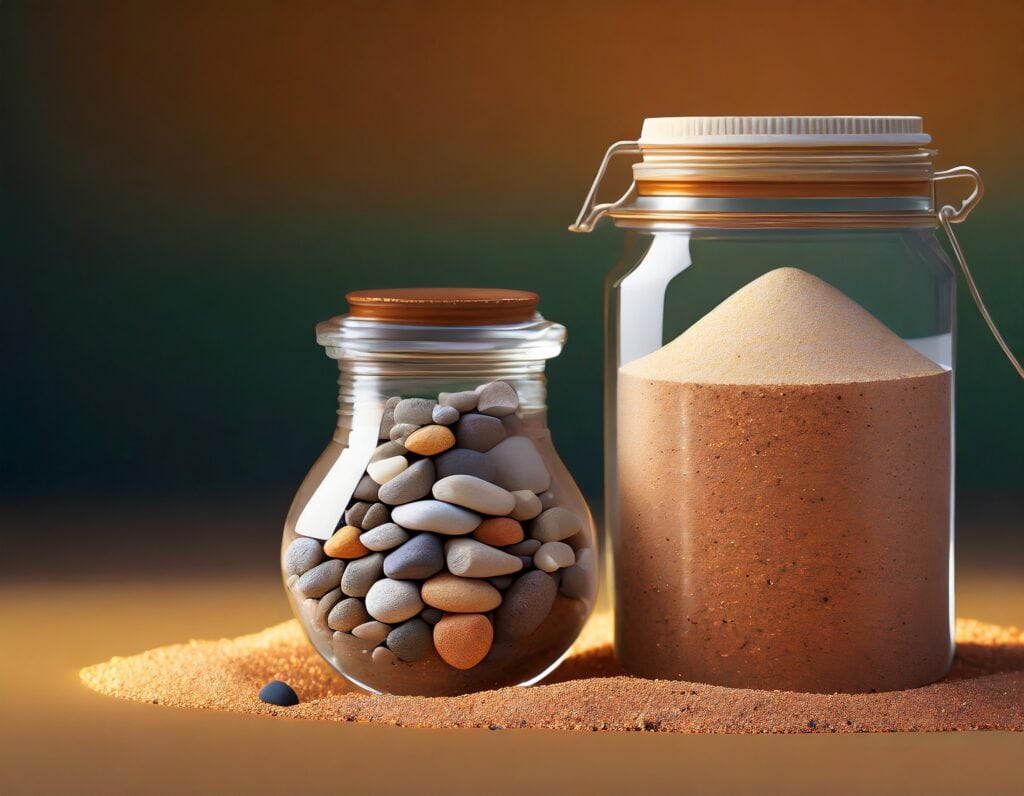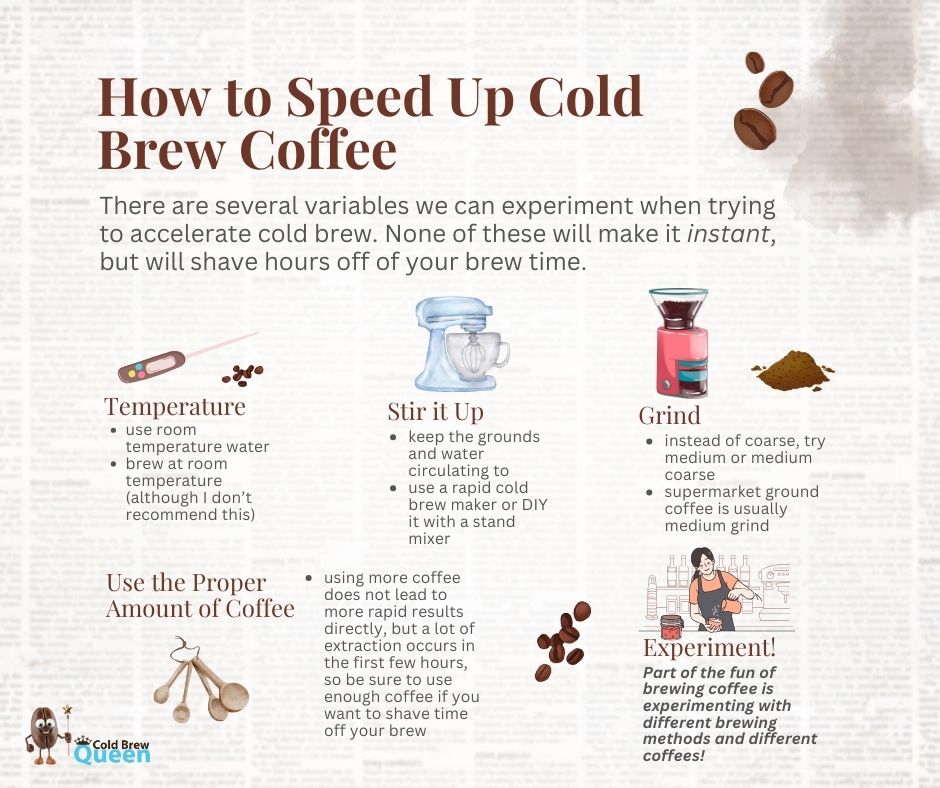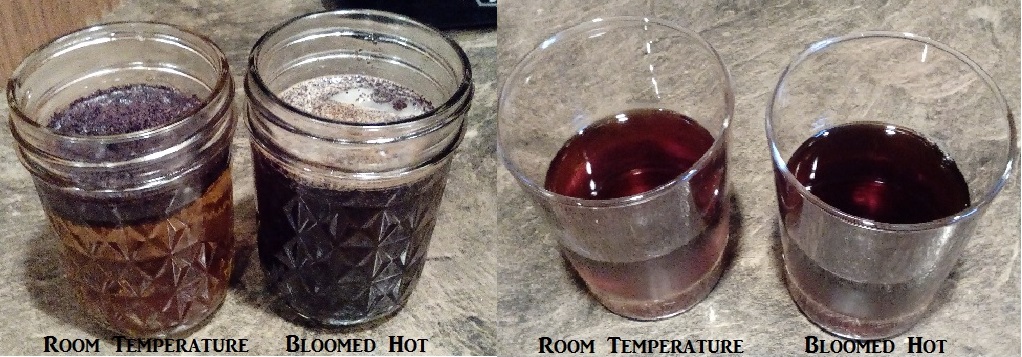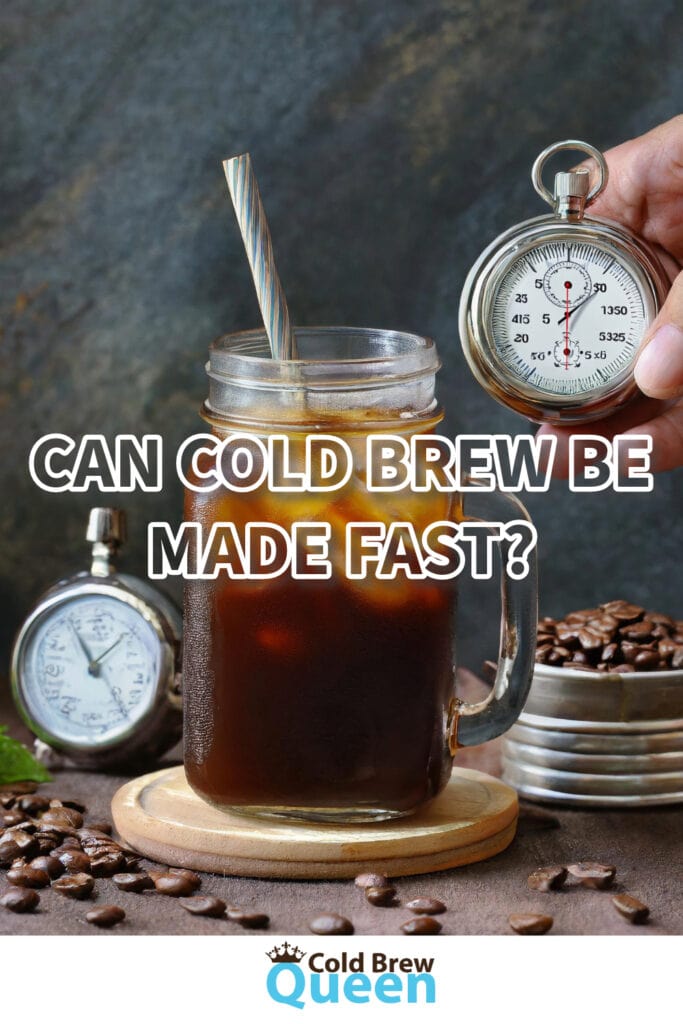Can You Brew Cold Brew Fast? Methods to Accelerate the Process
This post may contain affiliate links. If you make a purchase through a link I may earn a commission. As an Amazon affiliate I earn from qualifying purchases.
If you are looking for my thoughts on consumer rapid cold brew makers skip to the sections starting with Agitation Brewers in the table of contents below.
Cold Brew Basics: The Problem With Fast
Cold brew coffee relies on time rather than heat to extract flavor from your coffee beans. The downside is it takes a long time. There’s no whipping up a cold brew from scratch on a whim (unless you use a concentrate, but we are talking about from scratch here).
Typically, cold brew can either be made by immersion or drip:
Cold Brew Coffee Made with Immersion
- Method: Coffee grounds are steeped in cold water for an extended period (typically 12-24 hours).
- Flavor: Results in a full-bodied, smooth, and slightly more acidic flavor profile.
- Brew Time: Requires a longer brew time due to the immersion process.
- Equipment: Can be made with simple equipment like a jar or pitcher.
- Texture: Often produces a heavier mouthfeel due to prolonged contact with the grounds.
Cold Drip Coffee
- Method: Water slowly drips through a bed of coffee grounds over several hours.
- Flavor: Yields a lighter, brighter, and less acidic flavor compared to immersion cold brew (but it can still be bold and smooth if you use more coffee).
- Brew Time: Typically faster than immersion cold brew due to the drip process.
- Equipment: Requires specialized equipment like a cold drip tower or slow drip system.
- Texture: Tends to have a cleaner and more subtle taste profile with a lighter body.
The choice between the two methods comes down to personal preference for flavor, texture, and brewing time.
Manipulating Time with Traditional Cold Brew
There are different variables we can experiment with when trying to speed up cold brew.
The interaction between time and temperature can influence the taste and quality of your final cup.
Temperature
Cold brew can be made at room temperature or in the fridge.
- Room temperature brews faster, in 12-20 hours
- In the fridge takes longer, 16-24 hours, because the colder temperatures slows down extraction.
The location you choose may affect taste and safety. Water grows things at room temperature and cold brew coffee is not acidic enough to prevent this. I recommend the fridge for safety.
Time
Brewing time is the other major variable to consider. Aim for 12-24 hours to avoid bitterness. That said, after 2-hours, a large part of the extraction has already occurred. It’s kind of like the 80/20 rule of cold brew.
What about grind?
- Coarse grinds require longer brew times (12-24 hours) due to their reduced surface area. There is less total surface of coffee bean exposed to the water.
- Finer grinds have more surface area exposed to the water. When using finer grinds, reduce the brew time to avoid over-extraction, which can cause bitterness. Also, if you use too fine a coffee there may be less water circulation and less water in contact with the coffee, meaning extraction will be incomplete
Pre-ground supermarket coffee is usually medium grind, although coffee marketed as being for cold brew may be coarsely ground
As an analogy, consider a jar of sand and a jar of pebbles. If you add the same amount of water to each jar and then try to swish the water around, the water can circulate in between the pebbles, but in the sand it may just be absorbed by the sand and not move much.

For a faster brew, use finer grinds & shorten the immersion time.
Remember, your perfect brew comes down to your personal preferences. Use these tips as a starting point to finding your ideal cup of cold brew.
Grind Size and Ratio
This study on cold brew coffee examines the effects of several variables on the brewing process including ratio. They found that using more coffee to water resulted in more extracted coffee (as measured by total dissolved solids) but did not reduce the time needed to brew.
Here’s a quick reference table for starting points for grind sizes and ratio. Adjust the times and ratios:
| Grind Size | Brew Time | Coffee-to-Water Ratio | Note |
|---|---|---|---|
| Coarse | 12-24 hours | 1:8 | Standard, balanced extraction |
| Medium | 7-12 hours | 1:7 | Faster, may increase body and flavor intensity |
| Fine | Not recommended | N/A | Risk of over-extraction |

Laboratory Methods to Accelerate Cold Brew
Scientists have been studying ways to accelerate cold brew extraction. While some of these methods are out of reach for the consumer, it is interesting to see what has worked.
| Method | Can be done at home? |
|---|---|
| Ultrahigh Pressure | No |
| Heat Pre-Treatment | Yes |
| Ultrasonic | No |
| Agitation | Yes |
| Vacuum Cycling | No* |
| Particle Size Adjustment | Yes |
| Lasers | No 🙁 |
Ultrahigh Pressure (UHP) Assistance:
Utilizing UHP technology can shorten the duration needed for cold brewing. UHP works by damaging the cellular structure of the coffee grounds, which makes extraction more and thereby shortens the time it takes.
The increased pressure also helps extract flavors and compounds like chlorogenic acid and trigonelline more effectively.
Heat Pre-treatment:
One of my early experiments in cold brewing was whether blooming the coffee a bit first with hot water would make a difference in flavor. It did, it tasted a bit more like iced coffee.
You can also see a big color difference. The room temperature one with the same amount of coffee looks weaker.

It turns out a brief heat treatment to your coffee grounds before immersing them in cold water may enhance the extraction rate.
By heating the grounds slightly, the extraction process can start faster when moved to a cold environment.
Ultrasonic and Agitation:
Using ultrasonic waves or stirring the coffee-water mixture can speed up the extraction process by circulating grounds through the water and promoting faster release of coffee compounds into the water.
Note: If you really wanted to try ultrasonic extraction at home, you could look into a jewelry cleaner that has a removable tank that can be washed. I haven’t tried this, but it’s a fun idea. If you try this, have one dedicated to food!!
Vacuum Cycling:
Using vacuum cycles during brewing can speed up extraction, showing significant effects in a little over an hour. This technique involves altering pressure multiple times to improve water absorption into the coffee grounds.
Particle Size Adjustment:
Adjusting the grind size of your coffee can also speed up the process. Finer grounds increase the surface area in contact with water, which can lead to a faster extraction of flavors and compounds.
Lasers:
Cold zapped coffee?? Lasers have been used to extract coffee in just 3 minutes. The results were similar in chemical composition to cold brew coffee, but of course most of use don’t have a laser at home. Someday, maybe.
Agitation Brewers
To speed up cold brewing, agitation is available to the home barista. This method does shave hours off the brewing time, typically reducing time to under an hour.
For agitation:
- You’ll need a container that allows you to swirl or stir the coffee grounds in water.
- Several rapid cold brewers have agitation built in (see a few options below).
A kitchen stand mixer, especially one with a glass bowl and paddle attachment is a good DIY option.
Note: A blender or food processor would not be a good idea because the blade would pulverize the coffee grounds and you’d end up with coffee soup.
The rapid cold brewers I have tested recommend using medium grind coffee. As we’ve seen, reducing grind size is one way to speed up extraction.
Place coffee and water in the bowl and start stirring. Stir for 20-40 minutes. If using a stand mixer, use one of the lowest settings.
Strain the coffee from the water.
If you are using a rapid cold brewer, follow the manufacturer’s instructions. Some examples of rapid cold brewers include:
- Presto Dorothy Cold Brew (read my review)
- Vinci Cold Brew Maker
- Dash Rapid Cold Brew Maker
But How Does it Taste?
These devices promise a drink in as little as 15 minutes. They all use agitation to speed extraction.
I have tried two different devices: The Presto Dorothy and the Forias (no longer available). The latter created agitation by pumping the water back and forth through the grounds in a filter basket. Results from both were underwhelming.
Initial Taste Test: If you give your cold brew only 15 minutes to brew, you’ll likely find the flavor lacking. It tends to taste weaker compared to a brew that’s been steeped overnight. .
Tweaking the Time: By extending the brewing to around 30 minutes, and then letting it sit and settle for another 15-20 minutes the flavor is improved, but still not optimal.
At this point though, we have spent about 45 minutes. I can get a much better flavor from my cold dripper and by the 45 minute mark, enough has dripped through to grab at least a small glass to tide me over.
Texture and Clarity: The biggest drawback of rapid cold brewing is the cloudiness of the coffee. Even after straining through a paper filter, the constant movement during brewing led to a cloudier glass of coffee.
This might be an acceptable trade-off for some, particularly when in a rush, but for if you like a crystal-clear cold brew, this may be a sticking point.
Better Alternatives
Consider exploring other rapid options like the drip-style Mueller Quick Brew or the Recafimil Cold Dripper, which may produce a less cloudy brew while still speeding up the process compared to traditional methods.
The absolute fastest way to get a good tasting cold brew at home? Use an ultra-concentrate like:
- Jot
- Javy
- Starbucks Single Serve Concentrated Pods
- Java House Single Serve Liquid Pods
These tend to work out to about an average of $1.50 per serving, but can be worth having on hand in case of a coffee emergency.



